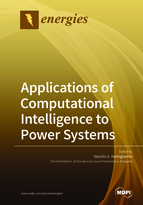Applications of Computational Intelligence to Power Systems
A special issue of Energies (ISSN 1996-1073). This special issue belongs to the section "F: Electrical Engineering".
Deadline for manuscript submissions: closed (10 August 2019) | Viewed by 25158
Special Issue Editor
Interests: neural networks; fuzzy systems; genetic algorithms; hybrid systems; machine learning; image/signal processing; bio-signal analysis; chemometrics; control; non-invasive sensing systems; robotics
Special Issues, Collections and Topics in MDPI journals
Special Issue Information
Dear Colleagues,
In power system operation and control, the basic goal is to provide users with quality electricity power in an economically rational degree for power systems, and to ensure their stability and reliability. However, the increased interconnection and loading of the power system along with deregulation and environmental concerns has brought new challenges for electric power system operation, control, and automation. In the liberalised electricity market, the operation and control of a power system has become a complex process because of the complexity in modelling and uncertainties. Computational intelligence (CI) is a family of modern tools for solving complex problems that are difficult to solve using conventional techniques, as these methods are based on several requirements that may not be true all of the time. Developing solutions with these “learning-based” tools offers the following two major advantages: the development time is much shorter than when using more traditional approaches, and the systems are very robust, being relatively insensitive to noisy and/or missing data/information, known as uncertainty. Prospective authors are invited to submit original contributions or survey papers for review for publication in this Special Issue. Topics of interest include, but are not limited to, the following:
- Power system operation (including unit commitment, economic dispatch, hydro-thermal coordination, maintenance scheduling, congestion management, load/power flow, and state estimation)
- Power system planning (including generation expansion planning, transmission expansion planning, reactive power planning, and power system reliability)
- Power system control (such as voltage control, load frequency control, stability control, power flow control, and dynamic security assessment)
- Power system automation (such as restoration and management, fault diagnosis and reliability, and network security)
- Forecasting application (such as short-term load forecasting, electricity price forecasting, long term load forecasting, wind power forecasting, and solar power forecasting)
- Distribution system application (such as the operation and planning of a distribution system, demand side management and demand response, network reconfiguration, and the operation and control of a smart grid)
- Distributed generation application (such as distributed generation planning, operation with distributed generation, wind turbine plant control, solar photovoltaic power plant control, and renewable energy sources)
Dr. Vassilis S. Kodogiannis
Guest Editor
Manuscript Submission Information
Manuscripts should be submitted online at www.mdpi.com by registering and logging in to this website. Once you are registered, click here to go to the submission form. Manuscripts can be submitted until the deadline. All submissions that pass pre-check are peer-reviewed. Accepted papers will be published continuously in the journal (as soon as accepted) and will be listed together on the special issue website. Research articles, review articles as well as short communications are invited. For planned papers, a title and short abstract (about 100 words) can be sent to the Editorial Office for announcement on this website.
Submitted manuscripts should not have been published previously, nor be under consideration for publication elsewhere (except conference proceedings papers). All manuscripts are thoroughly refereed through a single-blind peer-review process. A guide for authors and other relevant information for submission of manuscripts is available on the Instructions for Authors page. Energies is an international peer-reviewed open access semimonthly journal published by MDPI.
Please visit the Instructions for Authors page before submitting a manuscript. The Article Processing Charge (APC) for publication in this open access journal is 2600 CHF (Swiss Francs). Submitted papers should be well formatted and use good English. Authors may use MDPI's English editing service prior to publication or during author revisions.
Keywords
- Neural networks
- Deep learning systems
- Fuzzy systems
- Evolutionary computing
- Machine learning
- Forecasting
- Control
- Scheduling
- Reliability
- Distribution networks






